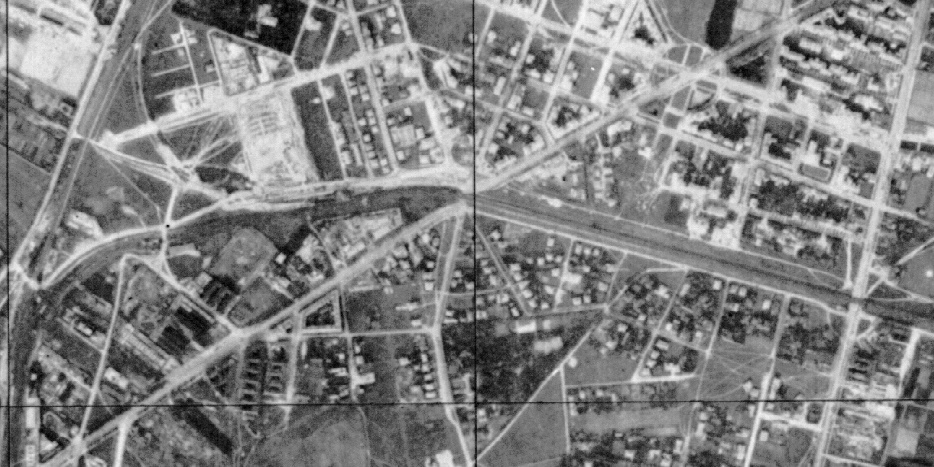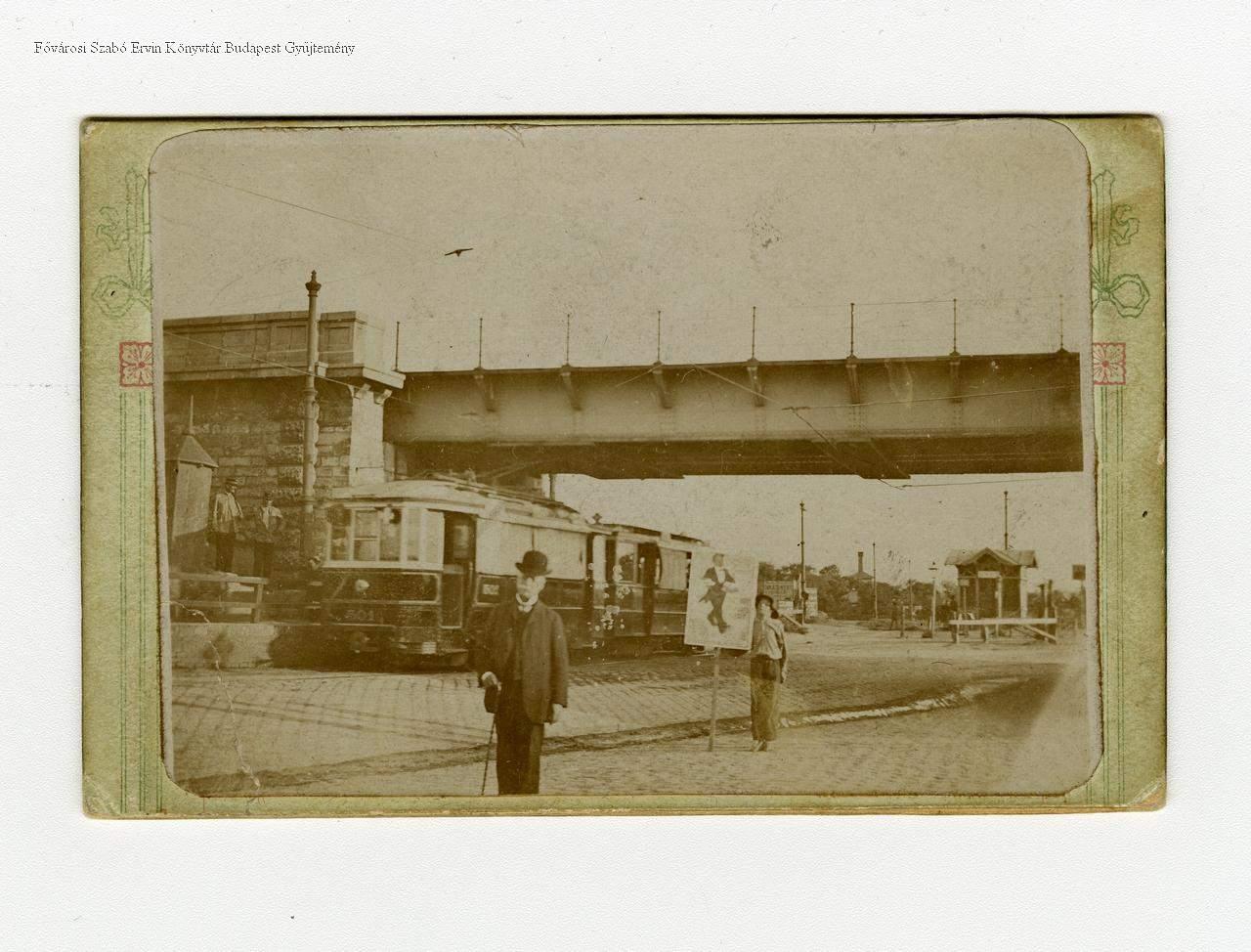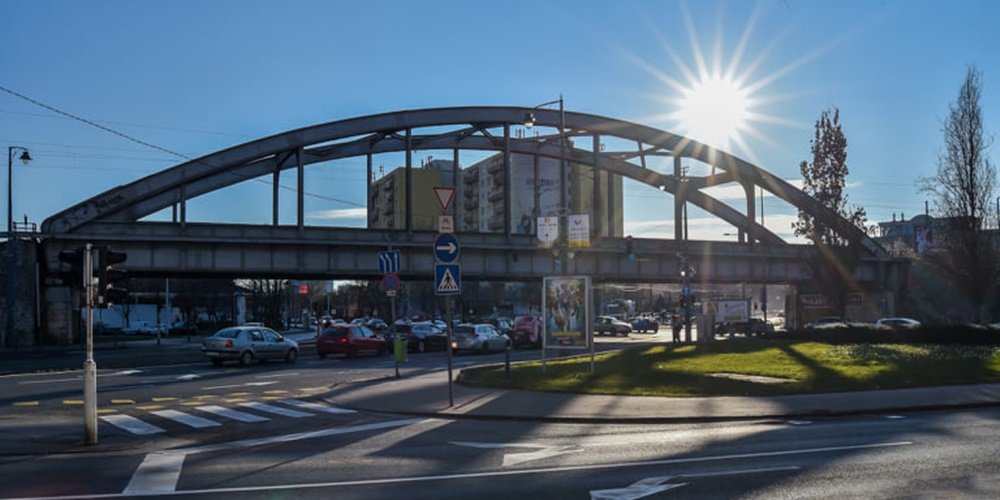The railway line dividing Kelenföld is almost 150 years old. It was opened in 1877, the same year its embankment was built. At the time the entire area was almost deserted, and only a few plans for utilizing the Kelenföld-Lágymányos lowlands had been drawn up. Thus the embankment was not in the way of anything.
At the beginning of the 20th century, the development of the area between Gellért Hill and the railway began. A map drawn before the Second World War shows that at the time a small, only 15-metre-long, bridge stood where the present-day Bartók Béla Road (Horthy Miklós Road at the time) crossed under the railway.

The narrow bridge on an aerial photo from 1940 (Photo Fortepan/No.: 25072)
At the time only five narrow crossings existed through the embankment, including the one used by Horthy Road. These narrow passages were destroyed during the siege of Budapest. The 15-metre bridge was blown up on 5 January 1945. As the rail line was vital, quick bridges of wood and iron were constructed to ensure traffic flow. However, these quickly fell into disrepair.

The old overpass at the beginning of the 20th century (Photo: FSZEK Budapest Collection)
It was immediately obvious that the old bridge would no longer suffice. A new, larger structure was planned to cross the traffic artery Bartók Béla Road had become. The current bridge was built according to plans by Imre Korányi in 1949. It was the first tied-arch bridge on the MÁV rail network. Tied arch bridges are similar to a combination of arch bridges and girder bridges.
The Maderspach-type of girder bridge can in fact be considered a Hungarian innovation, as Károly Maderspach designed the first such structures in the 1830s. He even submitted a plan for such a bridge on the design tender for the first permanent Danube bridge between Buda and Pest.
As the new 70-metre bridge was more expensive than rebuilding the old crossing, MÁV was reluctant to cover the costs alone. In 1948 the Minister of Transport decided that MÁV should cover 50% of the expenses, with Budapest and the – then non-existent – Public Works Committee covering the other half together. The bridge cost 8 million HUF at the time.
However, by the time construction began, the Public Works Council had been abolished, and the capital had to pay for the complete remaining 50%. The new bridge was opened to traffic on 16 September 1949. Friss Ujság reported on the landscaped area on 5 December 1949:
"The capital has tidied up the area surrounding the railway overpasses on Soroksári Road, Budafoki Road, Fehérvári Road and Bartók Béla Road. As a part of work, turns in the road are being straightened and the hairpin bend of the train tracks will also be eased."
The bridgeheads were designed in a way that they could later be converted into pillars. At the time, plans for the expressway to Lake Balaton started from this road section, meaning that a second bridge of the same span would have been added after the newly constructed one. These plans were never realised.

A similar, elegant and simply geometric bridge was designed as a replacement in 2017 (Photo: MSc Kft.)
The 67-metre-long, two-track rail bridge over Bartók Béla út turned 71 this year. On the one hand, the structure is old and weakened. On the other, the railway expansion means four tracks will pass through the section, needing a bridge twice the width of the current one.
Plans were made in 2017 for a similar but more modern structure. However, at the time only three tracks were planned on a span-length similar to the current design. The MSc Kft. design team received a design prize for the plans in 2018.
In a Facebook post, Dávid Vitézy, CEO of the Budapest Development Centre, wrote the following about the planned development project:
“New railway bridges with longer spans than the current designs will be built instead of the Bartók Béla út overpass at the Karolina Road – Tétényi Road intersection to accommodate the four tracks that will run along the section due to the development of the Southern Ring Railway. As a result of the larger span, more space will open up between the pillars and bridgeheads, allowing for the creation of an urban plaza instead of the current unnamed, cramped junction. The aim is to allow cyclists and pedestrians to cross the area comfortably from all directions, improve access to the tram and bus stops to ease transfers and to give local residents a new, organised plaza. The reconstruction also opens the door to new greens and the option to plant trees."
Residents are also invited to contribute to the planning process through an online questionnaire on delikorvasut.hu. The plans have already changed compared to those published three years ago. At the beginning of the 2010s, plans were to have a bridge of similar length with an increased width to accommodate three tracks. Current plans are for a much larger bridge.
The bridge will be 93 metres long and wide enough to support four tracks.
Hopefully, the currently unnamed intersection of Buda, which is the meeting point of six roads: Tétényi, Bartók Béla, Sárbogárdi Roads and Vincellér, Hamzsabégi and Kovászna Streets will become a beautiful, planned public space, crowned by a beautiful modern rail bridge.
Cover photo: The current bridge (Photo: Balázs Both/pestbuda.hu)





































Hozzászólások
Log in or register to comment!
Login Registration